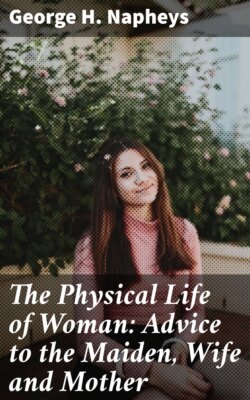Читать книгу The Physical Life of Woman: Advice to the Maiden, Wife and Mother - George H. Napheys - Страница 9
На сайте Литреса книга снята с продажи.
PUBERTY.
ОглавлениеTable of Contents
At a certain period in the life of the female, she ceases to be a girl, and becomes a woman. Hitherto she has felt no distinction between herself and the boys, her playmates. But now a crisis takes place, which is for ever after to hedge her round with a mysterious, invisible, but most real barrier from all mankind.
This period is called the age of puberty. Its sign is a flow of blood recurring every month; its meaning, that the female has entered upon that portion of her life whose peculiar obligations are to the whole race—no longer to herself alone. The second part of her twofold nature is opened. Why is it that on her, the weaker sex, this extra burden is laid? Why this weakness, these pains, this recurring loss of vital fluid?
Perhaps, as has been observed, it is a wise provision that she is thus reminded of her lowly duty, lest man should make her the sole object of his worship, or lest the pride of beauty should obscure the sense of shame. But this question concerns rather the moralist than the physician, and we cease asking why it is, and shall only inquire what it is.
To this science returns a clear reply. In the anatomy of woman there are two small bodies, in shape and size like large almonds, called the ovaries. They lie one on each side of the womb, and are connected with it by tubes about four inches in length. These bodies are solid, but contain a great number of diminutive vesicles, which, by some mysterious law of nature, mature one at a time, every thirty days, for thirty years of woman's life. When mature, the vesicle separates from the ovary, traverses the tube into the womb, and is thence expelled and lost, or becomes, by contact with the other sex, the germ of a living being. This process is accompanied by a disturbance of the whole system. Wandering pains are felt; a sense of languor steals over the mind; the blood rushes with increased violence through the vessels, and more or less of it escapes from the veins, causing that change which we term menstruation.
The ancients had a tradition that in the beginning of things the world was made from an egg; the naturalists of past generations had this maxim: Everything living comes from an egg; and science to-day says the same. For this vesicle we have mentioned is in fact an egg, similar in structure to those which birds, fish, and turtles deposit. The only differences are, that the one is developed out of the body, the other within; the one has a shell, the other has none.
Therefore physiologists give this definition: Menstruation is ovulation—it is the laying of an egg.
